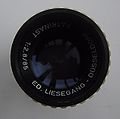- Cooke triplet
-
Cooke triplet 
Introduced in: 1893 Author: Dennis Taylor Construction: 3 elements in 3 groups Aperture: f/3.5 (early)
f/2.8 (rare-earth optical glass)The Cooke triplet is a photographic lens designed and patented (patent number GB 22,607) in 1893 by Dennis Taylor who was employed as chief engineer by T. Cooke & Sons of York. It was the first lens system that allowed elimination of most of the optical distortion or aberration at the outer edge of lenses.
A Cooke triplet comprises a negative flint glass element in the centre with a crown glass element on each side. In this design, the sum of all the curvatures times indices of refraction can be zero, so that the field of focus is flat (zero Petzval field curvature). In other words, the negative lens can be as strong as the outer two combined, when one measures in dioptres, yet the lens will converge light, because the rays strike the middle element close to the optic axis. The curvature of field is determined by the sum of the dioptres, but the focal length is not.
At the time, the Cooke triplet was a major advancement in lens design. It was superseded by later designs in high-end cameras, but is still widely used in inexpensive cameras, including variations using aspheric elements, particularly in cell-phone cameras.
Contents
Early designs
Despite the fact that the Cooke design was patented in 1893 it seems that the use of achromatic triplet designs in astronomy appeared as early as 1765. The 1911 Encyclopædia Britannica wrote:
- The triple object-glass, consisting of a combination of two convex lenses of crown glass with a concave flint lens between them, was introduced in 1765 by Peter, son of, John Dollond, and many excellent telescopes of this kind were made by him.
This parallels the fact that John Dollond had in turn patented the achromatic doublet in the 1750s, though it had been used decades earlier.
Application
-
Triotar-Triplet on a Rollei range finder camera
The triplet soon became a standard in lens design still used with low-end cameras today. The main optical manufacturers often further developed the original Cooke triplet (e.g., the Zeiss Triotar) that were produced for many decades.
Binoculars as well as refracting telescopes often use triplets. The same holds for many projection lenses, e.g., for 35 mm slide projectors.
A similar design is used in the strong focusing synchrotron, invented first by Nicholas Christofilos in 1949, but his work was not known in the U.S., where parallel development took place.
See also
External links
Categories:- Photographic lens designs
Wikimedia Foundation. 2010.



